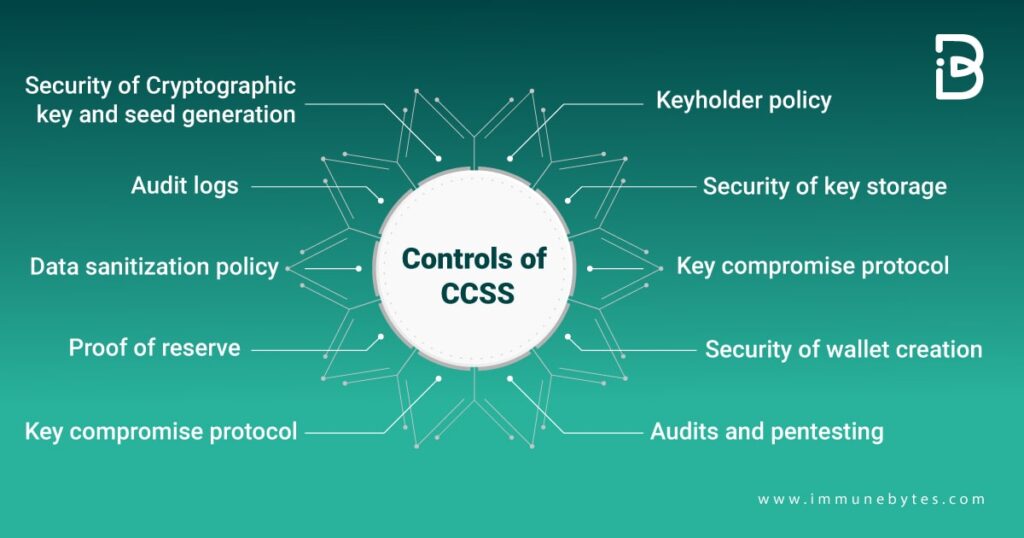“With Cryptos expected to leap into the mainstream, one of the hurdles is confidence. Can Cryptocurrency Security Standards (CCSS) bridge the gap? “
It’s no secret that cryptocurrencies are here to stay and will be seen evolve as the mainstream currency sometime in the future. Nevertheless, this shift would not be happening too soon. Until then, a lot of “shake out” will be expected within the web3 space.
In the current scenario, the biggest challenge of cryptos that is seen is confidence. Users are skeptical about crypto transaction loopholes in authentication, authorization, and confidentiality. Maybe, these are the issues that have hindered the adoption of cryptocurrencies globally within the Web 3.0 world until now.
What can be done to bring improvement to the situation? One of the most effective ways to do this is by standardizing the security techniques and methodologies that cryptosystems use worldwide. However, many cryptos like Bitcoin do not have a central “authority,” making it tedious to standardize on security.
This is where Cryptocurrency Security Standard (CCSS) comes into play. In this blog, we will ponder this security standard and see how it can curb the existing problems within the crypto domain.
ImmuneBytes is a paradise for people seeking top-notch smart contract auditing services. We’ve been the pioneers in this industry, and our cybersecurity professionals are here to solve all your queries quickly!
So, let’s get started.
What Is Cryptocurrency Security Standard (CCSS)?
Table of Contents
Cryptocurrency Security Standard (CCSS) is a fixed set of requirements for every information system that uses cryptocurrencies. These include cryptocurrency storage solutions, processors, crypto marketplaces and games, exchanges, and web applications. However, CCSS may or may not apply to CCSS restrictions.
CCSS is an open standard created to supplement current standards (ISO 27001, PCI DSS, etc.) and normal information security procedures to safeguard cryptocurrency information against illegal data access, sensitive data loss, and breaches.
For every corporation that handles and administers crypto wallets as part of its business logic, CCSS is presently the de facto security standard.
This standard is a control framework with ten controls and three implementation tiers. Let us discuss them.
Ten Controls Of The Cryptocurrency Security Standard
10 CCSS requirements cover any information system that saves, uses, or accepts Cryptocurrency. You will receive a score between three compliance levels based on how secure each component of your system is. This can be either hardware or software. The ten security aspects are organized into two categories that are the foundation of CCSS: Cryptographic Asset Management and Cryptocurrency operations.

Let us break down these ten controls into the two categories discussed above. This will give you an idea of what you need to focus on to comply with CCSS completely.
Cryptographic Asset Management
- Security of Cryptographic key and seed generation
‘Seed phrase’ is a sequence of words users requires to access their cryptocurrency wallets. From a cybersecurity point of view, you will find that the most vital aspects of Cryptocurrency are generating keys and seeds. Naturally, they must be something unique that hackers can’t guess. If the hacker guesses the 64-character seed, it won’t be a cakewalk for them to gain access to your funds.
Working with your CCSS compliance partner, make sure that all of the following areas are covered in your key & seed generation methods to achieve basic compliance:
- Sufficient entropy pools
- Operator-created keys and seeds
- DRBG compliance
- Validating the methodology that has been used for the creation
- Wallet creation
If you’ve been an old player in the cryptocurrency industry, you would know what crucial role a wallet plays in your conducting your business. You can use digital wallets to purchase, store, and trade a wide array of cryptos.
So, these aspects of CCSS deal with creating a Bitcoin wallet or addresses that users can use to send and receive Cryptocurrency. Different signing methodologies, such as single, multiple key signatures, etc., are used to create wallets.
To comply with CCSS when creating wallets, the following considerations must be made:
- Unique address per transaction
- Organizational distribution of keys
- Multiple keys for signing
- Geographic distribution of keys
- The redundant key for recovery
- Deterministic wallets
- Key storage
This is the third aspect of CCSS that deals with storing private keys and seeds when they are not used. CCSS mandates that they must be stored “as securely as business concerns will allow.” This helps maintain the best confidentiality of the seed data and key. To keep these secure, you want to use physical locks, encryption, secret sharing, etc.
When you want to meet the key storage requirements, you need to cover the following:
- Primary keys are stored in encrypted
- The backup key is encrypted
- Backup key exists
- The backup key has a tamper-evident seal
- The backup key has environmental protection
- The backup key is access-controlled
- Key usage
Like key storage, this aspect of the CCSS ensures that all the keys and seeds are securely used. This is done to enhance the confidentiality of private keys and ensure the integrity of the funds.
When utilizing keys, there are a variety of hazards that might have serious harmful effects. A few possible outcomes include fund loss, key manipulation by malware, and unlawful transactions by harmful outside actors.
As per CCSS, these aspects must be considered for compliance.
- Key access requires a user password and authentication
- DRBG compliance
- Keys are only used in a trusted environment
- Two keys aren’t used on a single device
- Operator reference checks
- Spends are verified before signing
- Operator ID checks
- Operator background checks
- Key compromise protocol
As the old age saying goes, “Hope for the best, plan for the worse,” the cryptocurrency world is no exception. Thus, CCSS mandates that there should be a protocol to account for the keys/seeds that have been hacked. It must plan and outline all the actions taken after a hack.
Key Compromise Protocol (KCP) is necessary for your organization to reach the highest Level III certification under CCSS.
KCP compliance consists of the following:
- Have an existing KCP
- Regular KCP training and rehearsals
- Keyholder access procedures
CCSS lays standards about how users are granted access to the seeds that store the funds of the users. You must consider how your personnel uses information systems and restrict access to data that is not necessary for them to carry out their usual tasks. All new hires should have their backgrounds checked. Access should be quickly revoked when an employee leaves or is fired since improper onboarding and offboarding can also put important and sensitive information at risk.
The key access procedure compliance plan includes the following:
- Granting access and revoking procedure checklist
- Grant and revoke audit trail
- All requests made via authenticated communication channel
Cryptocurrency operations
- Security audits
This aspect deals with the third-party reviews of security systems, policies that protect from risks, and technical controls. To determine the potential vulnerabilities, it is a must that you conduct penetration and vulnerability tests.
Additional Read: list of smart contract vulnerability
No matter how technically skilled, knowledgeable, and experienced the employees that create and manage your systems are, outside evaluations are required to find hazards and control flaws that your internal team may have missed or misjudged.
A cryptocurrency system’s security should be evaluated by someone other than those who implement it because software development businesses demand that third parties test a product to determine its feasibility. When considering your security solutions, third parties offer a different perspective, are unaffected by technological controls, and are better equipped to be unbiased.
The only requirement, yet the most important to this aspect of CCSS, is: to make sure you conduct a third-party smart contract security audit. You can rely on ImmuneBytes, a pioneering organization for top-notch web3 cybersecurity services.
- Data sanitization
You might need to delete cryptographic keys from hardware or digital storage. This may be anything from cellphones and cloud servers to USB devices and hard disks for PCs. Hackers are now using more complex digital forensic techniques to retrieve data that has (apparently) been destroyed or wiped.
Thus, CCSS ensures proper sanitization of digital media when they are removed from your facilities. You need to ensure that you have removed all the digital media devices.
You must follow this checklist during your data sanitization procedure (DSP).
- Have an existing DSP
- Maintain audit trail of all media sanitization
- Proof of Reserve
To provide liquidity for all users as they purchase, sell, and cash out to other currencies, cryptocurrency exchanges and wallets need to have enough money in “reserve,” just like a bank. CCSS requires companies that deal in cryptocurrencies to demonstrate control over all reserve monies kept in their systems.
This restriction was created partly due to instances in the past where cryptocurrency companies only used a small portion of the reserves they claimed to have. This is a significant risk since Bitcoin exchanges and wallets must be able to cover all funds if all users withdraw money simultaneously. Proofs of reserve assure the public that all monies are always accessible, eliminating the possibility of fund loss.
To reach CCSS compliance, conduct proof of reserve audits regularly.
- Audit logs
Last, you must keep track of system maintenance audit logs that offer a history of all recent modifications. Audit logs may be very helpful to investigators in the case of a breach or cybersecurity incident in understanding how the attack happened, correctly diagnosing symptoms, and developing a strategy to fix problems and stabilize your systems and service.
You must ensure to apply audit logs and that there is always a backup of audit logs if you wish to reach minimum Level I CCSS compliance.
Three Implementation Levels of CCSS
The total CCSS score of your system will increase the more security features your company uses. Depending on your organization’s total CCSS score, you might be at Level I, II, or III. Your firm must pass a stringent external audit to demonstrate its proficiency in these ten security criteria if it wants to receive a CCSS grade.
Let us see what these levels are:
Level 1
When the external audit reveals that most threats to the system’s information assets have been handled through the adoption of controls that adhere to industry standards, Level, I CCSS security has been attained. Despite being the lowest level, Level I firms are nonetheless thought to have robust cryptocurrency security procedures.
Level 2
When the external audit concludes that the firm has established high standards of cryptocurrency security and attempts to develop increased controls over the assets of its information system, Level II CCSS security is achieved. The organization follows CCSS Industry standards and takes precautions to ensure the assets are not compromised. The company is also advancing cryptocurrencies by creating a decentralized system with numerous signatures for each transaction.
Level 3
Achieving Level III CCSS security means that the business has improved levels of security via the creation and adoption of established internal policies and processes, according to the external audit. All company members follow these policies and procedures while dealing with cryptocurrencies. The external audit must conclude that the company has also put in place cutting-edge systems for ensuring the validity and transparency of Bitcoin data at all times. To demonstrate their resilience in the face of a cybersecurity catastrophe, digital assets should be handled and kept carefully.
Conclusion:
Therefore, whether you’re a crypto investor, business, or exchange, you should now be aware of the purpose of CCSS, the topics it addresses, and the actions you can take right away to achieve complete compliance and have your company ready to confront cyber threats. Remember to take into account working with a CCSS compliance partner to make your journey even more productive and stress-free.

